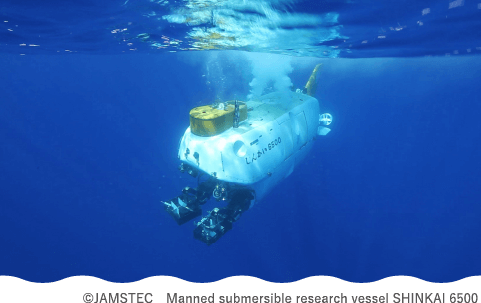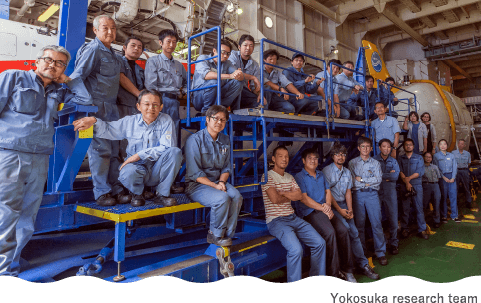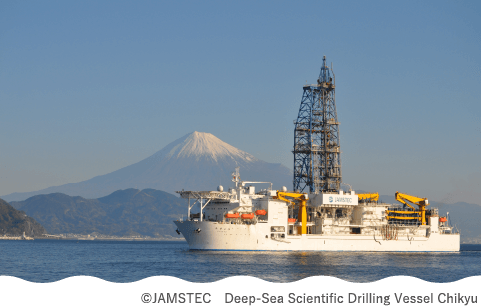
A.JAMSTEC (Japan Agency for Marine-Earth Science and Technology) started in 1971 as the Japan Marine Science and Technology Center and celebrated its 50th anniversary on October 1, 2021. Many people may be more familiar with the manned submersible research vessel SHINKAI 6500, the Earth Simulator supercomputer, or the deep-sea scientific drilling vessel Chikyu, rather than the name JAMSTEC. JAMSTEC is recognized as a comprehensive research institute for marine science and technology and is still called the "Research Institute of the Ocean" as we continue to operate seven ships, including research vessels and more. Although we're called that, we focus on more than just the ocean. The ocean accounts for 70% of the earth's surface; as stated in our Vision (https://www.jamstec.go.jp/e/about/vision/), we aim to understand the Earth through the ocean and understand the life that characterizes the Earth. As such, JAMSTEC's cross-disciplinary and interdisciplinary research is conducted by experts with various specializations.
JAMSTEC is divided up into three big departments that act as the basic pillars of our research: those that deal with so-called global environmental issues, those that deal with mainly geodynamics, and those working on marine objects as submarine resources for human use. I personally don't pay much attention to these sections and feel like I'm involved in everything.

A.Yes, I just joined it on October 1 of this year, but I was part of the Institute for Extra-cutting-edge Science and Technology Avant-garde Research (X-star) until then. I was also part of the Submarine Resources Research Center until about three years before that.

A.I joined in April 2009.
A.I do research on gases, including methane and hydrogen gas. Gases that dissolve in water are either deep sea microorganisms' food or excrement, so examining those gases can tell us how those creatures live. I used this to study creatures living in extreme environments in the deep sea and in areas with seafloor hot springs. I also research those creatures themselves, but I started to wonder why hydrogen and methane come from the seafloor in the first place. I found that it's because volcanic activity and earthquakes release hydrogen and methane from within the earth into the ocean; to understand that, I also researched earthquakes and volcanoes. Also, because earthquakes and volcanoes are part of the process of creating submarine resources, researching hydrogen and methane can help us understand where said resources are. In a narrow sense, my specialty is gases that dissolve in water, but being involved in various projects at JAMSTEC that relate to that specialty have led me to be part of more varied work over time.
A.I went to both Minamitorishima and Okinotorishima Islands.
A.I haven't actually stepped foot on Minamitorishima Island itself, but I've been to the area many times as there are submarine resources in the waters surrounding it. I went most recently in 2018 and 2020.

A.I actually go to locations even farther than Minamitorishima Island, but I haven't yet gotten to that island in the JAMSTEC research vessel. It takes four days to reach Minamitorishima Island's offshore research location from the Port of Yokosuka. However, I can't do research just by sailing the vessel there; what happens is that I take four days to sail to Minamitorishima Island to do research, stay there for about two weeks, and then spend four more days doing nothing while sailing back to Yokosuka.

A.The seafloor off the coast of Minamitorishima Island is known to have resources, so my goal is to assess environmental impacts there. This study is for a so-called environmental assessment to check how creatures living in that area would be affected if we started a project to extract the submarine resources there. Through a simple environmental assessment, it's easy enough to imagine that the sea cucumbers and tiny jumping shrimp visible to us would be killed. However, the water and seafloor are also home to smaller, single-cell prokaryotic microorganisms and other microorganisms that cannot be seen without microscopes. We need to dig up the seafloor to take resources from under it. When doing so, I think that when the mud from the seafloor flies up and spreads around, the fish and plankton living both on the seafloor and in the water would be affected by that murkiness. Thinking about what direction that murkiness would fly up in and how fast it would go is an important part of understanding the project's impact on microorganisms. Also, collecting those submarine resources involves lifting them up on top of the vessel. Some of the resources will fall off of the ship, which may also affect the water's surface. All of that put together makes up environmental assessments, which is the work I'm doing.
A.Generally, submarine resources are largely considered to be energy resources such as petroleum and natural gas, as well as elemental resources like gold, silver, and rare-earth elements. The Minamitorishima Island area is known to contain muddy sediment resources filled with rare-earth elements, which are the current target.
A.Yes. As an example, there is research in progress to determine the amount of resources that exist. There are literal tons of rare-earth elements in the EEZ (Exclusive Economic Zone) based around Minamitorishima Island. Researchers are looking at how many decades or centuries Japan could use that for if it was all collected. There's also research being done to determine its quality. If the rare-earth elements are extremely concentrated, they'll be easy to work with later and be economically profitable, too. Thus, a study is underway to determine where rare-earth elemental resources are concentrated in terms of their quality and quantity, and there's also a separate study in progress on developing technologies to dig up those elements.
A.There are creatures like sea cucumbers and fish, the same kinds found in every deep sea environment. There are also pure white crustaceans called Gammaridea, and others. We use a research device called Edokko-1 in our research, and it was built by the power of small-town factory workers in Japan. We tie a fish—such as Pacific saury—to the device as bait, and then put it on the seafloor. If you continuously watch the seafloor through the Edokko-1's camera, you can see the creatures that come to eat the fish. That's another type of study we're doing.
A.We can only see through video, so we can guess that some fish are close to others that we know based on their shape. However, we can't decide for sure what kind of creatures we see without catching them and doing genetic analysis. If we're looking at a fish, we can study it through the picture and figure out what kind of fish it is to some degree based on the placement of its pectoral and dorsal fins.
A.Minamitorishima Island is the only Japanese island on the Pacific Plate. It's well known that it sits on a different plate than Honshu; however, especially because that plate formed 100 million years ago, the deep sea environment surrounding that island is very different from other Japanese islands. It was thought that there would be resources there, but the creatures living on the seafloor were also assumed to be entirely different. Being on the Pacific Plate seemed to indicate that the seafloor creatures there would more closely resemble those near America or off the coast of Hawaii, rather than those living in the waters near Japan. Tokyo has the image of being a uniform city in a condensed area, and Minamitorishima Island is probably the sole Japanese island with its unique characteristics. It's very interesting that the island is part of Tokyo yet also not. Once a wharf is constructed and everyone can get to Minamitorishima Island easily, I think the island will have a lot of potential in various areas.